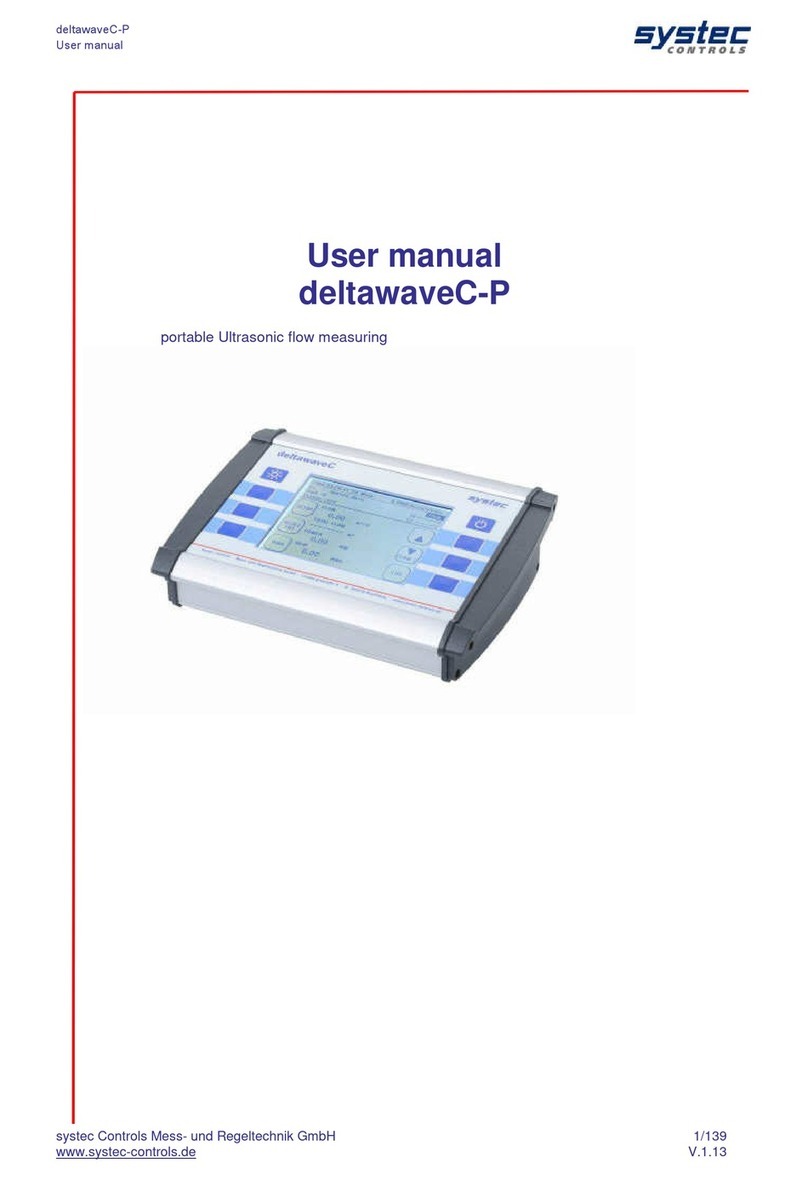
deltawaveVER2//LEAN Technical Reference and User’s Manual
systec Controls Mess- und Regeltechnik GmbH Rev. 1.2
Content
1deltawaveVER2 Description 4
1.1 Measurement principle 4
1.2 Applicable Standards 4
1.3 Measurement Accuracy 4
1.4 Specialised applications 5
2Specifications 6
2.1 Sensors 6
2.2 Evaluation unit 6
2.2.1 Acoustic path 6
2.2.2 Analogue inputs for water level sensors 6
2.2.3 Display with buttons 7
2.2.4 Analogue outputs 7
2.3 Cable for ultrasonic transducers 7
2.4 Certifications 8
2.4.1 Safety standards and EMC guidelines 8
2.5 Interface specifications (VER2 and VER2 LEAN) 10
2.5.1 Analogue inputs 10
2.5.2 Analogue outputs 10
2.5.3 Relay outputs 10
2.5.4 Pulse outputs 10
2.5.5 USB interface 10
2.5.6 RS232 interface 10
2.5.7 RS485 interface 10
3Flow calculation 11
3.1 Calculation algorithms 11
3.1.1 In “Partially filled/filled conduits, open channel” mode 11
3.1.2 Crossing paths 15
3.1.3 In “Full conduit” mode 15
3.2 Water level measurement 15
4Installation of the electronic unit 16
4.1 Electrical connection 16
4.2 Power supply (AC) 16
4.3 Ultrasonic board (only VER2) 17
4.4 Switch-Configuration (VER2) 18
4.5 Connector Board (only LEAN) 19
4.6 Connection hints (LEAN) 20
4.7 Function of the relay (LEAN) 20
4.8 Parameterization of the pulse output (LEAN) 21
4.9 Parameterization of the deltawaveLEAN pulse output hardware (LEAN) 21
4.9.1 Operating mode 1: High Side (PNP-Switch) (LEAN) 22
4.9.2 Operating mode 2: LOW Side (NPN-Switch) (LEAN) 23
4.9.3 Operation Mode Push-Pull 24
4.10 Connecting the Ultrasonic Transducers 25
4.10.1 Connection in areas liable to contain explosive atmospheres 25
4.11 I/O board (VER2) 26
4.12 Connection of water level measuring devices to the analogue inputs 27
4.13 Connection to the analogue outputs 27
4.14 Handling with Parameter-Files 27
4.14.1 Activating a transferred parameter file 27
4.14.2 Downloading an active parameter file from deltawaveVER2 to USB memory stick 27
5User-defined settings 28
5.1 General information on software use 28
5.1.1 Creating a new parameter file 28
5.1.2 Loading a new parameter file 28
5.1.3 Language selection 28
5.2 System configuration 29
5.2.1 Definition of existing hardware 29
5.3 Section configuration 30
5.3.1 Geometric definition of your conduit (drain) 33
5.3.2 not activated 33
5.3.3 open channel 33
5.3.4 “Define sampling points” sampling point editor 34
5.4 Path configuration 36




























